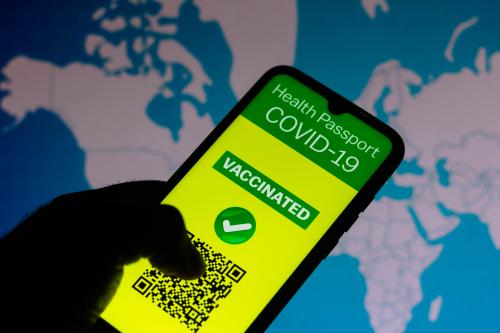The COVID-19 pandemic has catalyzed digital transformation in all aspects of our society, from politics and economics to education and health care systems. Unsurprisingly, the pandemic contributed to the skyrocketing adoption of information technologies, especially in the health care system. While only 43% of health centers were capable of providing telemedicine prior to the pandemic, this number increased to 95% over 2020. Insurance claims for telemedicine services also grew from roughly 529,000 in February 2020 to 12 million in April 2020.
The digital transformation of the health care industry is not merely restricted to increased use of telemedicine and telehealth, but also the creation of new care-delivery systems unexpectedly driven by agents external to the health care system, including new medical technology startups and retail companies. This also may be the very first time that agents outside of the market are leading changes inside the health care market, with new entrants to the market challenging the role that traditional health care providers have played. While the expansion of approved telehealth services and higher insurance reimbursements by the Centers for Medicare & Medicaid Services (CMS) paved the way for remote health care, dramatic changes in patient and physician attitudes, coupled with high return expectations of venture capitalists and entry of retail companies into the health care market, have been key drivers of the current digital transformation.
A market that has traditionally been shielded from outside competition is now being disrupted by new, unconventional competitors. In turn, this has transformed the field of health information exchange (HIE), bringing forward the larger question of what their role in an evolving and highly competitive health care market.
The role of digital transformation in health care
CMS and various governmental institutions have been major players in transforming the health care system, especially in response to the global pandemic. During this time, the Centers expanded approved telehealth services to include emergency department visits, home visits, therapy services, and more. The Centers also removed existing restrictions against letting people use their homes as the originating site for telehealth, while allowing remote care to be provided across state lines.
These changes were coupled with higher insurance reimbursements through Medicare and Medicaid, in addition to Congressional legislation that required health insurance issuers to reimburse telehealth services. Facilitated changes would be further propelled by non-market actors such as technology and retail companies. As digital modes of health care delivery became more commonplace, both patients and physicians embraced the conveniences and flexibility of telehealth. The pandemic also created unique opportunities for startups and retail companies to enter the health care arena, and to innovate digital solutions and resolve existing inefficiencies.
Venture capital funding for digital health shot up 66%, from $8.9 billion in 2019 to $14.8 billion in 2020. During the pandemic, retail pharmacies such as CVS, Walmart, and Walgreens played key roles in vaccine distribution and testing efforts. The swelling of the traditional health care market has also encouraged retail companies such as Walmart, Amazon, and more to expand into the telehealth business.
Changing market dynamics for HIEs
Changing market dynamics are affecting traditional HIE organizations, which are used to electronically share patient data across doctors, hospitals, and specialty care providers in a confidential and secure manner. Most Americans’ medical information continue to be stored on paper, and electronic health records (EHRs) can be difficult to transfer across different systems because of technical barriers. The traditional value proposition of HIEs have been their ability to overcome these barriers and provide the comprehensive medical history of patients at the time of care. This facilitates provider communication, enabling a better use of resources by preventing duplicate testing or re-admissions. HIEs also help improve patient care by ensuring accurate diagnoses and medication prescriptions.
However, as technological standardization becomes more prevalent, more parties will be able to bypass HIEs and directly exchange information with each other. For example, health clinics run by increasingly dominant players like Walmart and CVS can collect and maintain their own health records on individual patients without having to integrate information into patients’ core medical records. Similarly, Apple’s new Health Records on iOS function allows users to input personal health data and communicate with doctors through EHRs. Epic, a major company that holds onto the medical records of 54% of patients in the U.S., is one notable company left out by Apple in the roll-out of this new function. Not only can these companies choose which HIEs to work with, but they disrupt the original purpose of HIEs, which was to centralize medical care for improved efficacy of patient care.
The aforementioned changes in the health care industry are likely to drastically alter HIE competitiveness in the new health care market. If HIEs are able to adapt and cooperate with new actors in the healthcare market, this could provide unique opportunities for increased interoperability and improved healthcare outcomes. In the remainder of the blog, we propose four strategies for HIEs to increase their value proposition and stave off the major challenges that HIEs will face in the digital transformation of health care.
1. HIEs must diversify network members and data types to stay relevant.
To remain competitive, HIEs must expand their user network and the types of data they exchange to also include non-health care data and entities. For example, they could play an integral part in COVID-19 vaccine verification. Applications such as CLEAR are quickly positioning themselves as the platform for vaccination verification. However, without any connection to a provider who can verify a patient’s vaccination record, CLEAR has no way to verify the authenticity of the vaccine card provided by the patient. HIEs can circumvent these problems by allowing patients to disclose their verified vaccination record and other data to third parties. HIEs can also capitalize on the expansion of data analytics technologies, which have created newer use cases for different types of data for both medical and business applications. Areas for expansion could include collaborations with pharmaceutical companies for trial recruitments, or use of patients’ medical data to assess nutritional needs or food purchasing patterns, especially in the case of chronic diseases like diabetes. By diversifying their network members, HIEs can support digital health tools, including prescription medication reminders or blood pressure checks. While these emerging capabilities meet the digital needs of the health care market, they may also be borderline privacy concerns, which should be considered by HIEs desiring to enter these new markets.
2. HIEs should include knowledge discovery in their focus.
HIEs should also expand their services to go beyond synchronous data exchanges and include more asynchronous data curation and information reporting services. That includes going beyond merely exchange data and instead extracting more valuable knowledge from such data. The current services of HIEs today can be best described as on-demand data query services. HIEs only pull certain data when an encounter happens, or a provider requests the information. At the very least, HIEs should focus on providing population-level health reports for public health officials. Over the COVID pandemic, unstandardized demographic data has made it difficult for health experts to conduct cross-state comparisons and analyze the impact of COVID-19 across different demographics. This is a gap HIEs could easily fill. HIEs should heavily invest in expanding their services to include high-end data analytics.
Such analytics will be essential in shaping the healthcare market going forwards. Over the pandemic, many restrictions on healthcare modality have been lifted, allowing more people to access telehealth through video conference, audio calls, and asynchronous means. This has opened up new avenues for research on the clinical efficacy of various modalities. HIEs provide unique support for providers to communicate across modalities while processing valuable data on how these technologies could improve healthcare.
3. HIEs should be working horizontally and vertically to meet patients and providers where they are.
Through horizontal integration, firms make mergers and acquisitions of other firms that are in the same position in the value chain and offer similar services. In contrast, through vertical integration, a firm can expand upward or downward the value chain and make mergers and acquisitions with other companies that are either suppliers or consumers of its own services.
One of the unique strategic advantages of HIEs is their access to medical data, something that is more difficult to obtain compared to other types of personal data. HIEs could build on this advantage through horizontal integration and increased interoperability with other HIEs across state borders or within regions. The merger between CORHIO and Arizona’s Health Current is a step in the right direction, combining data for approximately 1,800 health care organizations across two states and increasing opportunities for increased efficiency and innovation. An even more ambitious approach is the Patient Centered Data Home (PCDH) project led by the Strategic Health Information Exchange Collaborative (SHIEC), which seeks to increase interoperability and integrate all HIEs across the country.
Current vertical integration by HIEs should be expanded to non-traditional health companies: newcomer tech companies that are proposing new care-delivery models, and more established companies that are transforming specific sectors of the health care market. Companies that are taking on AI-enabled care-delivery services, such as the subscription-based primary-care model One Medical, the AI-and-smart-sensor assisted-living service for the elderly Zemplee, or the AI-based emergency room triage company AIdoc, embody new business models that can leverage HIE platforms and vice versa. Combining the wealth of medical data from HIEs and the analytics technology from these new companies can create instrumental synergies. Further, HIEs can establish relationships with new entrants into the health care market, such as Walmart and CVS with their onsite clinics and pharmacies. These companies collect vast amounts of data from their customers and optimize their services and products based on such data. They also understand the value of medical data from HIEs, and can be lucrative partners for them.
Future regulation can hinder HIE expansion and growth in a new health care market
Despite the significant potential for HIEs to expand their services and stay competitive in the evolving health care market, there are some major roadblocks for future expansions, including concerns over patient privacy and potential regulatory threats. Compounding this is the recent final adoption of the information-blocking prohibition rule from the Department of Health and Human Services, which may penalize companies for the implementation of certain business practices that could be considered as hindering information sharing, despite the provision of explicit exceptions.
Health data is sensitive information that, if utilized improperly, could harm consumers. In 2011, Fitbit made user profiles searchable, exposing the sexual activity of users in Google Search results. Online therapy app Talkspace was met with backlash when, in 2020, former employees alleged that their therapy chat logs were being used to improve machine learning and gain market insights. Respecting consumer privacy and ensuring transparency in communicating what data companies collect is essential to establishing trust and goodwill.
HIE growth can also be impacted by uncertain regulation, as in the case of the information-blocking prohibition rule. While clear exemptions have been put in place so that HIEs can continue to charge minimal fees for their services, there is still a risk that future services could be interpreted as a business practice designed to block information exchange. Further, the mere bureaucratic burden of a Health and Human Services Office of Inspector General inquiry can by itself be very expensive for small organizations, and can easily bankrupt a small upstart provider. The risk of negative publicity can also be detrimental to HIE organizations that are accused of information blocking. What adds to these challenges is that the rule is brand new under a new administration, and the COVID pandemic continues to evolve. There is very little precedent for policymakers to clarify how the rule would be interpreted and implemented.
These recent regulatory measures have put the HIE market on pause and only time can tell what happens next. If HIEs are going to evolve with the current digital landscape in health care, these and other concerns must be addressed.
Amazon, Apple, Google, and Walmart are general, unrestricted donors to the Brookings Institution. The findings, interpretations, and conclusions posted in this piece are solely those of the authors and not influenced by any donation.








Commentary
Maintaining health information exchange competitiveness in a new health care market
October 7, 2021